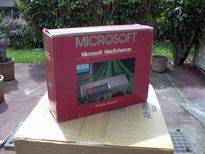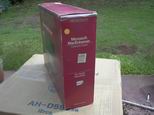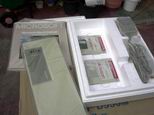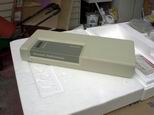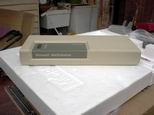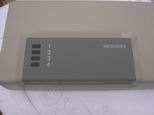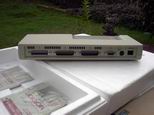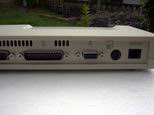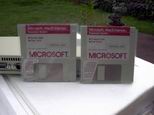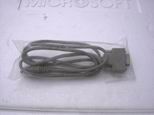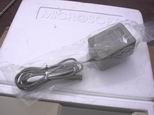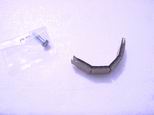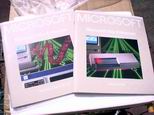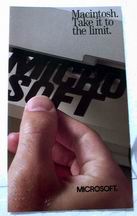
Apple
Museum For-A-Day
![]()
![]()
Microsoft MacEnhancer
November 2, 2002
Updated December 27, 2002
Copyright 1997-2010 Pearl City Networks. All Rights Reserved. This article
is not to be re-published without permission of the author.
Errata available at the bottom of this article...
The Microsoft MacEnhancer is a very special piece of equipment for Apple collectors. Released in late 1984, the MacEnhancer gives the Macintosh 128K or 512K features that it never had before, thereby enabling you to connect many IBM PC compatible devices to the Macintosh.
To give you a background of the Macintosh in relation to the MacEnhancer... The Macintosh 128K and 512K (and every Macintosh since then, right up to today's Power Macintosh G4 units) lacked the necessary ports to connect IBM PC compatible printers. In the early 1980's the IBM PC outnumbered the Macintosh in terms of available printers 10-to-1. When the Macintosh 512K came out late 1984, the only printers available for it at the time were the Apple ImageWriter and the Apple LaserWriter. The IBM-PC had many IBM and third-party printers available, including the Epson FX-80/100 and other Epson and IBM-compatible printers, as well as daisy-wheel printers. What's even more ironic is that the Apple II series had a much wider range of printers to choose from than the Macintosh.
The problem with printer compatibility on the Macintosh was the type of interface IBM-compatible printers used. Both the IBM PC and the Apple II (the Apple II required an optional printer card interface) utilized a printer interface that was in a parallel configuration, which was a much faster interface than a serial interface. I have absolutely no idea why Apple Computer chose not to add a parallel printer interface to the Macintosh.
Also, the Macintosh System Software came with only printer drivers for the ImageWriter and LaserWriter. So even if you jimmied up an IBM-PC compatible printer with a Macintosh serially, you still lacked the drivers to complete the connection.
That's where the MacEnhancer came into the picture. Not only did it provide the needed parallel printer interface, but it also allowed the Macintosh to utilize up to four devices on a single modem port. It allowed you to switch electronically between the four ports via a desk accessory. What you'd do is program each of the four ports with information, including the type of device (you could also use ports 3 an 4 for a modem or terminal), and the port configuration (baud rate, stop bits, parity). In 1985, the Macintosh System Software didn't have a Chooser yet (that was invented later on in System Software 5.0, I believe), so you had to run the desk accessory to switch between devices prior to use.
The MacEnhancer was Microsoft's very first hardware device to be manufactured for the Apple Macintosh. Microsoft earlier developed hardware products for the Apple II series, including the Microsoft SoftCard CP/M card. Around the same time MacEnhancer was selling, Microsoft also sold Microsoft Multiplan, Microsoft BASIC, and Microsoft Chart. After the release of MacEnhancer, Microsoft later released Microsoft Word and Microsoft File, both in Winter 1985.
In 1986, Microsoft bailed out of the Macintosh hardware business to focus strictly on application software. Microsoft sold the hardware and software rights to SoftStyle, Inc. of Hawaii Kai, Hawaii. SoftStyle made improvements on the software so it was compatible with later models of the Macintosh System Software. If I remember correctly, the SoftStyle software releases were compatible with System 6.0, including adaptation to the Chooser the Macintosh System Software originally lacked. SoftStyle was later purchased by Phoenix Technologies, Ltd. in 1988, and virtually all of the Macintosh products, including the MacEnhancer and Printworks for the Mac products, were killed. Phoenix did stick around in the printer langauge industry, creating PhoenixPage page description language that was a clone of Adobe Postscript.
As a side note, the SoftStyle programmers in the early 1990's started their own company, Momentum, Inc. in Honolulu. There, they developed the Momentum Port Juggler, which offered multiple serial ports, much like the MacEnhancer product. The Port Juggler lived up into the late 1990's, but died off when Apple ditched the serial ports with the release of the later models of the Apple Power Macintosh G3.
|
11/02/2002 - None to report. 12/27/2002 - Disk images from the MacEnhancer package are now available for downloading. Click on this link to reach the Downloads section. |
|
|
